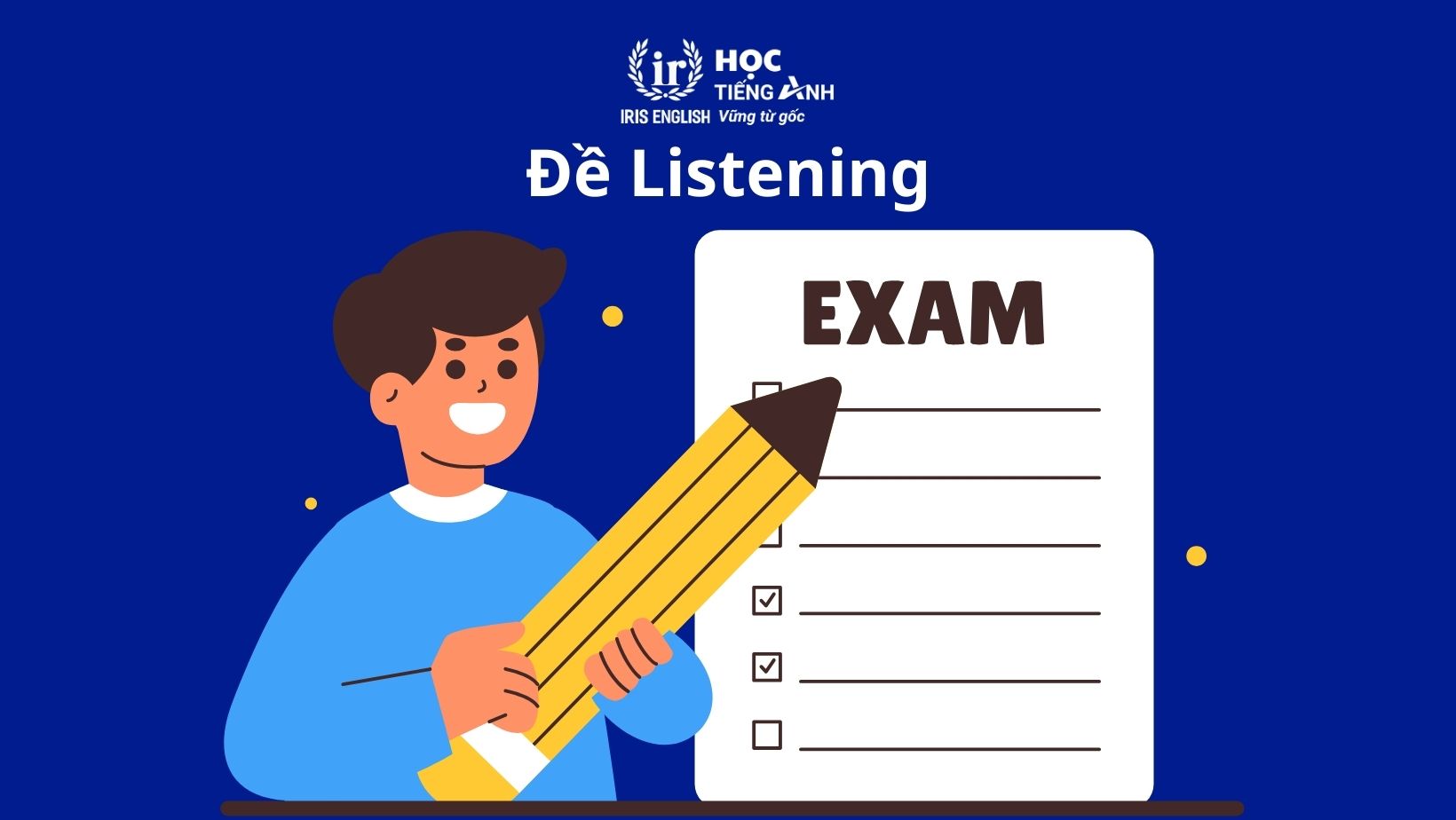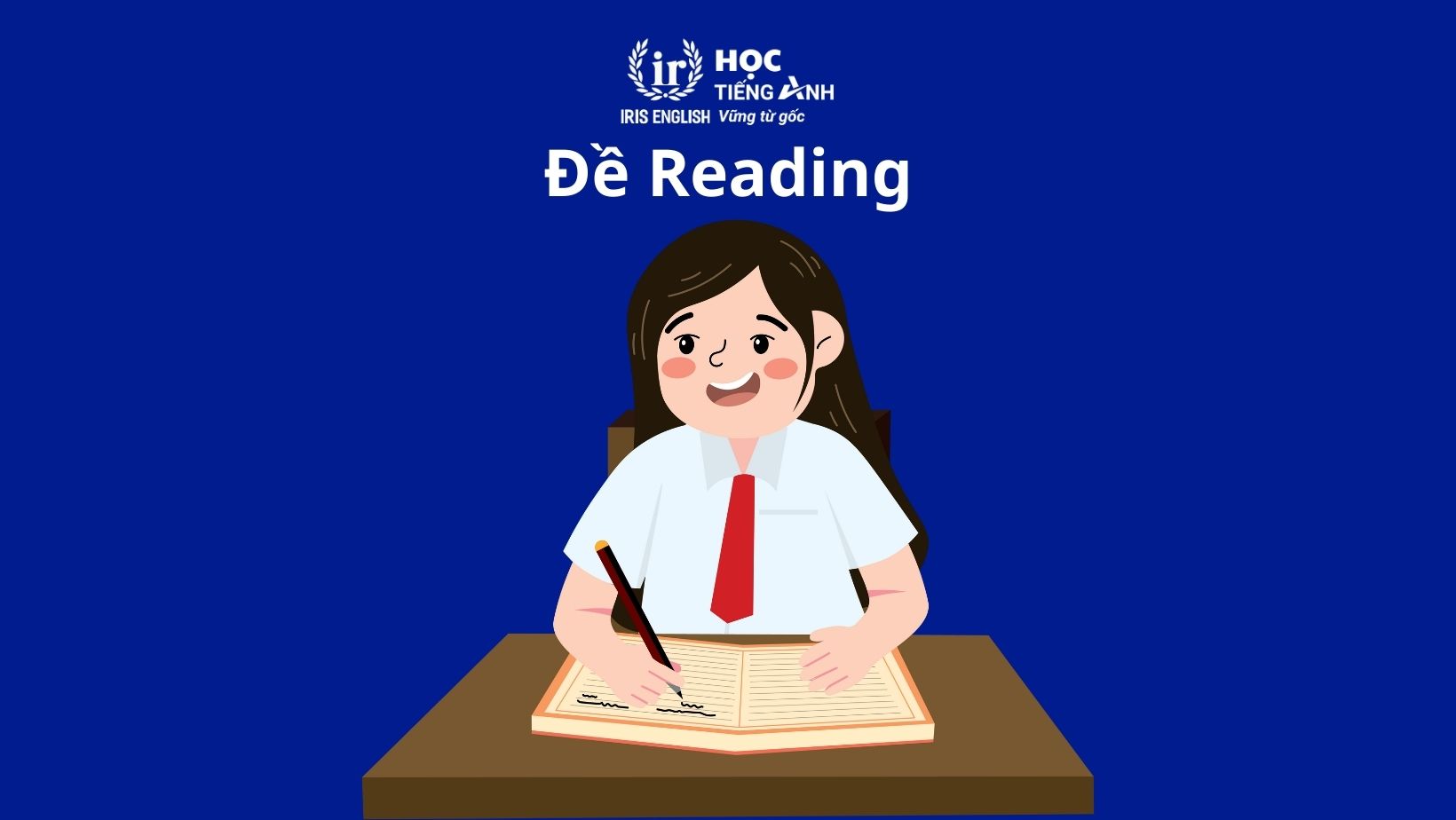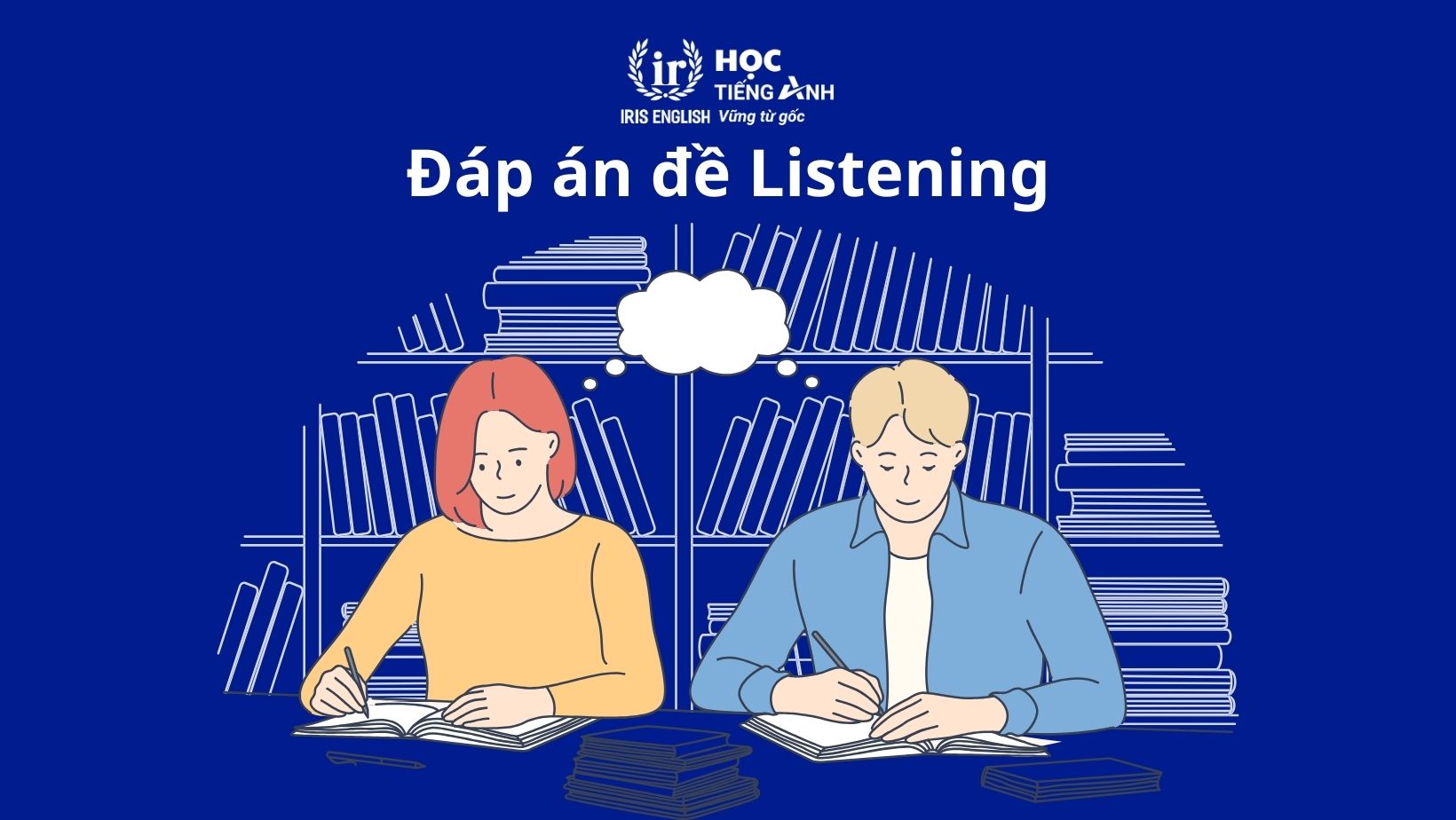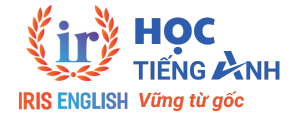Đề thi VSTEP luôn là mối quan tâm hàng đầu của nhiều thí sinh đang chuẩn bị cho kỳ thi đánh giá năng lực tiếng Anh theo khung năng lực 6 bậc. Hiểu được nhu cầu đó, IRIS English đã tổng hợp và cung cấp bộ đề thi VSTEP có đáp án chi tiết ở bên dưới, giúp bạn luyện tập hiệu quả và nâng cao kỹ năng nhanh chóng. Cùng khám phá ngay để sẵn sàng chinh phục kỳ thi nhé!
Đề thi VSTEP B1 – Listening
Part 1: Questions 1-8
You will hear eight short announcements or instructions. There is one question for each announcement or instruction. For each question, choose the correct answer A, B, C, or D.
-
What time will the library close today?
A. 8:00 PM
B. 7:00 PM
C. 6:00 PM
D. 9:00 PM
-
Which platform does the train to Brighton depart from?
A. Platform 2
B. Platform 6
C. Platform 4
D. Platform 8
-
What is the main purpose of the announcement?
A. To warn about severe weather
B. To notify a road closure
C. To advertise a new event
D. To remind about safety regulations
-
Where should students submit their project reports?
A. Room 101
B. Room 303
C. Room 300
D. Room 404
-
What time does the concert start?
A. 5:30 PM
B. 6:00 PM
C. 6:30 PM
D. 7:00 PM
-
What is included in the monthly gym membership?
A. Free yoga classes
B. Free swimming lessons
C. Complimentary personal training
D. Access to exclusive use of workout equipment
-
How long will the maintenance work last?
A. 1 hour
B. 2 hours
C. 4 hours
D. 3 hours
-
What should passengers do before boarding the bus?
A. Validate their tickets
B. Show their ID cards
C. Check the seating chart
D. Confirm their destination
Part 2: Questions 9-20
You will hear three conversations. There are four questions for each conversation. For each question, choose the correct answer A, B, C, or D.
Conversation 1: Questions 9-12
-
What is the man’s main concern about the accommodation?
A. The cost of rent
B. The size of the room
C. The distance to campus
D. The availability of facilities
-
What does the woman suggest about the utilities?
A. They are covered by the landlord.
B. They are included in the rent.
C. They are optional for students.
D. They need to be paid separately.
-
Why does the man prefer a single room?
A. To focus on his studies
B. To save money
C. To have more privacy
D. To avoid conflicts with the neighbors
-
What is the topic of the conversation?
A. Choosing a course
B. Finding accommodation
C. Budgeting expenses
D. Joining a student club
Conversation 2: Questions 13-16
-
What is the purpose of the woman’s trip?
A. Business
B. Education
C. Family visit
D. Leisure
-
Why does the man recommend the city tour?
A. It’s informative.
B. It’s affordable.
C. It’s popular with tourists.
D. It’s organized by locals.
-
What should visitors bring to the museum?
A. A guidebook
B. Their tickets
C. A camera
D. A student ID
-
What is the man’s role in the conversation?
A. A hotel receptionist
B. A tour guide
C. A travel agent
D. A tourist
Conversation 3: Questions 17-20
-
Why does the woman need help with her assignment?
A. She doesn’t know how to begin.
B. She missed the last lecture.
C. She has limited access to resources.
D. She is running out of time.
-
What does the man suggest using for research?
A. Online journals
B. Class notes
C. The library’s database
D. A reference book
-
How does the woman feel about group work?
A. Excited
B. Uninterested
C. Confident
D. Nervous
-
What is the conversation mainly about?
A. Preparing for an exam
B. Completing an assignment
C. Attending a workshop
D. Choosing a project topic

Đề thi VSTEP B1 – Listening
Part 3: Questions 21-35
You will hear three talks or lectures. There are five questions for each talk or lecture. For each question, choose the correct answer A, B, C, or D.
Talk 1: Questions 21-25
-
What is the talk mainly about?
A. Tips for healthy eating
B. The benefits of exercise
C. Managing stress effectively
D. Improving sleep quality
-
What does the speaker say about processed food?
A. It’s a good source of energy.
B. It should be consumed in moderation.
C. It’s harmful to the digestive system.
D. It’s better than fresh food.
-
How often does the speaker recommend exercising?
A. Daily
B. Three times a week
C. Once a week
D. Twice a month
-
Why is water important for health?
A. It helps to build muscles.
B. It prevents dehydration.
C. It provides essential vitamins.
D. It strengthens bones.
-
What is the speaker’s final advice?’
A. Maintain a balanced diet
B. Avoid junk food
C. Sleep early every night
D. Take supplements regularly
Talk 2: Questions 26-30
-
What is the lecture mainly about?
A. Climate change
B. Renewable energy
C. Conservation of water
D. Deforestation
-
What does the speaker emphasize about solar energy?
A. It’s widely available.
B. It’s expensive to maintain.
C. It’s not reliable in quantity.
D. It requires regular maintenance.
-
How does the speaker describe wind energy?
A. It’s economical.
B. It’s unpredictable.
C. It’s a limited resource.
D. It’s difficult to harness.
-
What is the biggest challenge for using renewable energy?
A. High initial costs
B. Lack of public awareness
C. Limited technology
D. Government restrictions
-
What does the speaker suggest is the most important aspect for promoting renewable energy?
A. Educating the public
B. Lowering costs
C. Offering subsidies
D. Increasing research
Talk 3: Questions 31-35
-
What is the topic of the lecture?
A. The importance of time management
B. Strategies for effective communication
C. Developing leadership skills
D. Enhancing creativity in the workplace
-
What does the speaker say about multitasking?
A. It improves productivity.
B. It reduces efficiency.
C. It’s a necessary skill.
D. It’s beneficial for team projects.
-
How can employees improve their communication skills?
A. By attending workshops
B. By practicing active listening
C. By using professional jargon
D. By giving frequent feedback
-
Why does the speaker mention deadlines?
A. To stress their importance
B. To suggest they’re flexible
C. To highlight their disadvantages
D. To recommend avoiding them
-
What is the speaker’s advice for managing workplace stress?
A. Take regular breaks
B. Focus on one task at a time
C. Communicate with colleagues
D. Seek professional help
Đề thi VSTEP B1 – Reading
You have 60 minutes to answer all the questions, including the time to transfer your answers to the answer sheet. Number of questions: 40.
Passage 1: Questions 1 – 10
What’s it like to work in extreme environments?
Four professionals share their experiences of working in some of the most challenging conditions on Earth.
Liam – Deep-Sea Diver
Diving into the unknown is both exhilarating and terrifying. The deep sea is a world of darkness and pressure where few humans have ventured. My role often involves maintaining underwater pipelines and investigating shipwrecks. The most dangerous part of my job is decompression, which, if done incorrectly, can be fatal. But what makes it worth it are the rare moments when I witness marine life that most people will never see in their lifetime.
Emma – Antarctic Researcher
Spending months in Antarctica is a test of both physical and mental endurance. The cold here is unimaginable, and the isolation can be tough. My work focuses on studying climate change through ice core samples, which reveal Earth’s history. The lack of sunlight during winter months is challenging, but the breathtaking beauty of the landscape and the chance to contribute to vital research keep me motivated.
Raj – Wildlife Photographer
Capturing images of animals in their natural habitats often requires weeks of patience and incredible resilience. I’ve spent days in extreme heat waiting for a single shot of a lion. One of my most unforgettable experiences was photographing snow leopards in the Himalayas. The altitude and harsh conditions pushed me to my limits, but the reward of capturing such rare beauty made it all worthwhile.
Sofia – Emergency Relief Worker
Responding to natural disasters or conflicts around the world is both physically exhausting and emotionally
draining. My team and I are often among the first to arrive, bringing supplies and medical aid. I’ve worked in
flood zones, earthquake-hit regions, and war-torn areas. It’s heartbreaking to see people in such desperate
situations, but being able to help even a little gives me a sense of purpose.
-
In the first paragraph, what does Liam mean by saying “Diving into the unknown is both exhilarating and terrifying”?
A. He enjoys the danger of his job.
B. His job is exciting but can be dangerous.
C. He knows everything about his work environment.
D. His work involves studying marine species.
-
What is the most dangerous aspect of Liam’s job?
A. Repairing pipelines
B. Encountering marine life
C. Incorrect decompression
D. Investigating shipwrecks
-
The word “isolation” in line 9 could best be replaced by
A. separation
B. loneliness
C. remoteness
D. boredom
-
What motivates Emma to continue working in Antarctica despite the challenges?
A. The chance to study rare animals
B. The beauty of the environment and meaningful work
C. The opportunity to work in complete darkness
D. The satisfaction of living in a unique location
-
What does Raj emphasize about his work?
A. The need for teamwork
B. The difficulty of traveling to remote areas
C. The patience and resilience required
D. The importance of preserving wildlife
-
The word “altitude” in line 18 is closest in meaning to
A. height
B. temperature
C. location
D. condition
-
According to the passage, who frequently deals with life-threatening conditions?
A. Liam
B. Emma
C. Raj
D. Sofia
-
According to the passage, who works in a highly isolated environment?
A. Liam
B. Emma
C. Raj
D. Sofia
-
The word “heartbreaking” in line 23 refers to something that
A. causes deep sadness
B. is physically exhausting
C. gives a sense of purpose
D. inspires hope
-
What is the main purpose of this passage?
A. To describe the daily routines of professionals in extreme jobs.
B. To highlight the challenges and rewards of working in extreme environments.
C. To compare the environment that people with different types of extreme jobs have to work in.
D. To explain how people train for jobs in harsh conditions.

Đề thi VSTEP B1 – Reading
Passage 2: Questions 11-20
The Secrets of Coral Reefs
Coral reefs are among the most biologically diverse ecosystems on Earth, often referred to as the “rainforests of the sea.” They host an incredible array of marine life, including fish, crustaceans, mollusks, and more. Despite their beauty and importance, these fragile ecosystems face numerous threats, many of which are caused by human activities.
Corals are actually tiny animals called polyps that belong to the phylum Cnidaria. These polyps form colonies, building massive calcium carbonate structures over time. What many people find extraordinary is that coral reefs cover less than 1% of the ocean floor but support around 25% of all marine species.
Coral reefs not only provide habitat for marine creatures but also offer vital benefits to humans. They protect coastlines from erosion by acting as natural barriers against storm surges and waves. Additionally, they contribute to the global economy through tourism and fishing. Coral reefs also hold great potential for medical advancements, as scientists study their organisms to develop treatments for diseases such as cancer and arthritis.
However, coral reefs are under threat from phenomena like coral bleaching. This occurs when corals expel the symbiotic algae that live in their tissues, causing them to turn white. Algae provide corals with much of their energy through photosynthesis, so bleaching often results in coral death. Rising sea temperatures, pollution, and overfishing are some of the primary causes of this distressing phenomenon.
Another significant issue is ocean acidification, which occurs when excess carbon dioxide dissolves into seawater. This process lowers the pH of the water, making it harder for corals to build their calcium carbonate skeletons. Without urgent intervention, coral reefs could face extinction within decades.
Just as forests on land require careful management to prevent deforestation, coral reefs need conservation efforts to survive. Governments, scientists, and local communities must work together to reduce carbon emissions, establish marine protected areas, and promote sustainable fishing practices, as well as establish marine protected areas. Public awareness campaigns can also encourage responsible tourism, ensuring that future generations will have the chance to marvel at the wonders of these underwater ecosystems.
-
The word “host” in the first paragraph is closest in meaning to _________.
A. produce
B. accommodate
C. threaten
D. remove
-
The author’s main point is _________.
A. to describe the ecological importance and threats to coral reefs.
B. to explain how coral reefs protect human populations.
C. to outline the process of coral bleaching in detail.
D. to emphasize the role of coral reefs in scientific research.
-
The author implies that coral reefs are unique in that _________.
A. they are made entirely of algae.
B. they cover a vast portion of the ocean floor.
C. they support a disproportionate amount of marine biodiversity.
D. they can recover quickly from environmental damage.
-
The word “barriers” in the third paragraph is closest in meaning to _________.
A. obstacles
B. shelters
C. divisions
D. filters
-
The word “their” in the third paragraph refers to _________.
A. humans’
B. corals’
C. coastlines’
D. organisms’
-
The phrase “turn white” in the fourth paragraph refers to _________.
A. the process of coral skeleton formation
B. the impact of algae on coral coloration
C. the bleaching effect caused by stress factors
D. the natural color of healthy corals
-
The author suggests that coral bleaching _________.
A. is a reversible process if addressed quickly
B. occurs naturally without human interference
C. results in the immediate death of all corals
D. is unrelated to climate change
-
The author mentions carbon dioxide to illustrate _________.
A. the main reason that caused coral reef degradation
B. the primary culprit of ocean acidification
C. the economic impact of coral reef tourism
D. the biodiversity of coral reef ecosystems
-
The term “marine protected areas” in the last paragraph refers to _________.
A. zones where fishing is banned permanently
B. regions designated for research on marine species
C. areas where human activities are regulated to conserve marine life
D. locations that are inaccessible to tourists
-
The author concludes that _________.
A. conservation efforts are futile in protecting coral reefs
B. humans are the primary reason for coral reef destruction
C. awareness and cooperation are essential to saving coral reefs
D. coral reefs are more resilient than most ecosystems
Passage 3: Questions 21-30
In the heart of Asia, a long-running political conflict between two neighboring countries has once again made international headlines. Tensions between Country X and Country Y have escalated in recent months, causing concern among global leaders and prompting calls for diplomatic intervention. Despite numerous peace talks and ceasefire agreements, the situation remains tense, with both nations accusing each other of violating international laws and undermining regional stability.
The roots of this conflict date back several decades to territorial disputes over land that both countries claim as their own. The area in question is rich in natural resources, including valuable minerals and water sources, making it a highly contested region. Over the years, several attempts have been made to mediate the dispute, but a lasting solution has yet to be found. In recent years, both sides have ramped up military activity in the region, heightening fears of a potential conflict that could have far-reaching consequences for neighboring countries and the international community.
As international organizations and peacekeeping forces prepare for possible interventions, many experts warn that the situation may be more complicated than it appears. The involvement of external powers, who have their own strategic interests in the region, could further fuel the conflict and make it even more difficult to resolve. Diplomatic talks, while crucial, may be insufficient if both sides are unwilling to compromise and prioritize peace over territorial ambitions.
Moreover, some analysts argue that the ongoing tension is not only a result of territorial disputes but also stems from broader political and economic factors. Both countries are vying for influence in the region, with each side seeking to assert its dominance in a rapidly changing geopolitical landscape. In this context, the conflict becomes a symbol of the larger power struggle taking place, and the stakes are much higher than a simple territorial dispute.
Despite the dire situation, there is hope that a diplomatic solution can still be reached. In recent weeks, both sides have agreed to engage in talks under the mediation of international peacekeepers, signaling a potential willingness to de-escalate the situation. However, the path to peace remains uncertain, and much will depend on the commitment of both nations to find common ground and work together for the greater good.
-
In paragraph 1, what does the phrase “causing concern among global leaders” mean?
A. It is attracting attention from world leaders.
B. It is making world leaders angry.
C. It is preventing world leaders from making decisions.
D. It is leading to economic collapse worldwide.
-
What is the main reason for the political conflict between Country X and Country Y?
A. A long-standing rivalry based on historical issues
B. A disagreement over international diplomatic alliances
C. Economic differences that affect global trade
D. Disputes over valuable land and natural resources
-
What is the author’s purpose in mentioning the “territorial disputes over land” in paragraph 2?
A. To highlight the importance of the region’s natural resources
B. To explain why the two countries are unwilling to compromise
C. To show that the conflict has been going on for a very long time
D. To demonstrate the complexity of the conflict’s historical background
-
What can the word “complicated” in line 16 be best replaced by?
A. Simple
B. Unclear
C. Challenging
D. Unlikely
-
According to paragraph 3, what makes the conflict more difficult to resolve?
A. The interference of external powers with their own agendas
B. The desire of both countries to negotiate peace
C. The willingness of both sides to compromise
D. The inability of the international community to intervene
-
Which of the following best describes the “broader political and economic factors” mentioned in paragraph 4?
A. A competition for political and economic influence between the two countries
B. The desire to protect valuable land from foreign investment
C. The need for both countries to increase their military power
D. The struggle to maintain global trade relations
-
In which space (marked A, B, C, and D in the passage) will the following sentence fit?
The military build-up in the region has made neighboring countries increasingly nervous.
A. A
B. B
C. C
D. D
-
According to paragraph 5, what does the author imply about the ongoing peace talks?
A. They are unlikely to lead to a long-lasting resolution.
B. They represent a positive step toward peace, despite the challenges.
C. They are not important to the future of the two countries.
D. They are being sabotaged by external forces.
-
Which of the following best describes the tone of the author in this passage?
A. Hopeful
B. Pessimistic
C. Critical
D. Neutral
-
Which of the following could best describe the message that the author wants to convey to readers?
A. The international community must take action to stop the conflict.
B. Resolving the territorial dispute will require more than just military intervention.
C. Peace is unlikely unless both countries agree to external mediation.
D. The situation can only be solved through peaceful negotiations and compromises.
Passage 4: Questions 31-40
The origins of human language have been the subject of intense study and debate for centuries. While there is no consensus among linguists and anthropologists regarding the exact timeline or processes involved in the emergence of language, several theories have emerged over the years. Some experts argue that language developed gradually as a way for early humans to communicate more effectively with each other, while others suggest that it arose suddenly due to a genetic mutation or a significant cognitive leap.
One of the most widely accepted theories is that language began as a form of gestural communication. Early humans may have used hand signals and body movements to express their thoughts and emotions before developing the ability to speak. Over time, these gestures would have become more complex, evolving into a fully developed system of vocal communication. Supporters of this theory argue that modern sign languages, which are used by deaf communities around the world, provide evidence of the link between gestures and language.
An alternative theory posits that language emerged suddenly due to a genetic mutation that allowed early humans to produce a wider range of sounds. According to this view, the development of the human brain, particularly the regions involved in speech production, enabled early humans to begin using vocalizations for communication. Some researchers believe that this mutation may have occurred as early as 100,000 years ago, during the time when Homo sapiens first emerged as a distinct species.
Other theories suggest that language evolved as a byproduct of socialization and the need for cooperation in early human communities. According to these theories, language was not a purposeful invention but rather a natural outcome of humans’ increasing need to work together for survival. The development of language, in this view, was driven by the growing complexity of human social structures and the need for coordinated effort in tasks such as hunting, gathering, and building shelter.
Despite the many theories about how language originated, it is clear that language has played a crucial role in shaping human societies. From the earliest cave paintings to the invention of writing, language has been central to human culture and communication. Today, linguistic diversity is one of the most defining characteristics of human society, with thousands of different languages spoken around the world.
-
The word ‘it’ in paragraph 1 refers to:
A. Communication
B. Language
C. Origin
D. Theory
-
According to the passage, which of the following is a possible cause for the emergence of language?
A. A sudden cognitive leap
B. The need for increased social cooperation
C. A mutation in vocal cords
D. All of the above
-
The phrase ‘gradually developed’ in line 5 is closest in meaning to:
A. Quickly evolved
B. Developed over time
C. Evolved in stages
D. Became less complex
-
According to the passage, which of the following is NOT true about the gestural communication theory?
A. It explain the start of vocalization in the emergence of language.
B. It suggests that language emerged suddenly due to a mutation.
C. It is supported by evidence from modern sign languages.
D. It is the most widely accepted theory among linguists.
-
According to the passage, what is one piece of evidence for the gestural communication theory?
A. The complexity of modern human language
B. The presence of cave paintings from early humans
C. The use of sign language by deaf communities
D. The discovery of ancient vocalization tools
-
What is meant by “a genetic mutation” in the context of the second theory?
A. A random change in the genetic code that allowed for more complex communication.
B. A purposeful alteration in human DNA to facilitate language.
C. A shift in human culture that led to the need for new sounds.
D. An adaptation to environmental changes that enhanced speech production.
-
Which of the following statements would support the theory that language developed as a social tool?
A. Language evolved from gestures used in early human societies.
B. Humans needed to work together for survival, leading to the development of communication.
C. Humans were able to make a wide variety of sounds, improving vocal communication.
D. The development of language was tied to the creation of written forms of communication.
-
Which of the following is NOT mentioned as a theory for the origin of language?
A. Language arose due to a genetic mutation.
B. Language began as a means of social cooperation.
C. Language was invented as a tool for written communication.
D. Language developed from gestural communication.
-
Which conclusion can be drawn from the passage?
A. Language is a unique trait found in certain human societies.
B. There is no single, universally accepted theory about the origin of language.
C. Language evolved gradually over thousands of years without any sudden changes.
D. Language is mostly a product of written communication and culture.
-
Which of the following best describes the organization of this passage?
A. A presentation of different theories followed by an analysis of their strengths and weaknesses.
B. A discussion of the role of language in society, followed by an exploration of its origins.
C. An explanation of the importance of language, followed by a list of competing theories.
D. A general overview of the history of language, followed by a discussion of its impact.
Đáp án Listening
Part 1: Questions 1-8
- 1.C
- 2.B
- 3.A
- 4.B
- 5.C
- 6.C
- 7.D
- 8.A
Transcript:
-
“Attention, all library visitors. Please note that today the library will close earlier than usual due to maintenance work. We will be shutting our doors at 6:00 PM. Thank you for your understanding.”
-
“Passengers traveling to Brighton, please proceed to Platform 6. The train will depart in 10 minutes. Once again, the train to Brighton is now boarding at Platform 6.”
-
“Severe weather conditions are expected in the area later today. Please take precautions, avoid unnecessary travel, and stay updated with the latest weather reports.”
-
“A reminder for students: project reports should be submitted to Room 303 by 5:00 PM today. Late submissions will not be accepted.”
-
“The evening concert at Central Hall will start at 6:30 PM sharp. Doors open 30 minutes before the performance. Please arrive early to secure your seats.”
-
“Join our monthly gym membership and enjoy access to all equipment, as well as complimentary personal training sessions. Sign up today to begin your fitness journey!”
-
“Attention, all residents: maintenance work on the water system will last approximately 3 hours. We apologize for the inconvenience and appreciate your patience.”
-
“Passengers boarding the bus, please ensure you validate your tickets before entering. Ticket machines are located near the entrance for your convenience.”

Đáp án LISTENING
Part 2: Questions 9-20
- 9.A
- 10.B
- 11.C
- 12.B
- 13.D
- 14.A
- 15.B
- 16.C
- 17.A
- 18.C
- 19.D
- 20.B
Transcript:
Conversation 1
-
Man: “I’m not sure about the cost of rent for this place. It seems a bit high for me.”
-
Woman: “I understand your concern, but the utilities are included in the rent. That saves you some money on bills.”
-
Man: “That’s good to know. Still, I think I prefer a single room to avoid any potential conflicts with roommates. Privacy is also important to me.”
-
Woman: “That makes sense. Finding accommodation that suits your needs is always a priority.”
Conversation 2
-
Woman: “I’m here for a leisure trip and looking to explore the city. Do you have any recommendations?”
-
Man: “Definitely! I’d suggest taking the city tour. It’s very informative and gives you a good overview of the main attractions.”
-
Woman: “That sounds great. What about the museum? Is there anything I need to know before visiting?”
-
Man: “Yes, make sure to bring your ticket with you. Also, it’s a good idea to check their schedule as they sometimes close for private events.”
Conversation 3
-
Woman: “I’m having trouble with this assignment. The topic is confusing, and I don’t know where to start.”
-
Man: “You should try using the library’s database. They have excellent resources that might help clarify things.”
-
Woman: “That’s a good idea. I’m also feeling nervous about working in a group.”
-
Man: “Don’t worry. Group work can be challenging, but it’s also a great opportunity to share ideas and learn from others.”
Part 3: Questions 21-35
- 21.A
- 22.B
- 23.B
- 24.B
- 25.A
- 26.B
- 27.A
- 28.B
- 29.A
- 30.A
- 31.A
- 32.B
- 33.B
- 34.A
- 35.A
Transcript
Talk 1:
Welcome, everyone. Today, we will focus on maintaining a healthy lifestyle.
A balanced diet, regular exercise, and managing stress are key to staying healthy. One of the most important aspects is healthy eating. Choosing natural, fresh foods over processed ones can make a significant difference. Avoid overconsumption of processed foods as they often contain unhealthy fats and added sugars, which can negatively affect your body. Processed food, while convenient, should be consumed in moderation. Whenever possible, opt for fresh fruits, vegetables, and whole grains to keep your energy levels up and ensure your body gets essential nutrients.
Exercise is another critical factor. Aim to work out at least three times a week. Activities like walking, swimming, or yoga can improve cardiovascular health, boost your mood, and keep your weight in check. Staying hydrated is equally essential. Drinking plenty of water helps prevent dehydration, keeps your organs functioning well, and even improves your skin’s appearance.
Lastly, maintain a balanced diet. Combine exercise, hydration, and adequate rest to achieve optimal health.
Talk 2:
Good morning! Today, we will discuss renewable energy sources and their importance in combating climate change.
Renewable energy is a sustainable way to reduce our dependence on fossil fuels. It includes solar, wind, and hydropower, among others. Each of these has unique benefits and challenges.
Solar energy, for example, is abundant and widely available. However, it’s not reliable in all climates, especially regions with limited sunlight. Proper infrastructure is necessary to make the most of it. Wind energy is eco-friendly and cost-effective once established. However, its unpredictability and dependency on specific geographic conditions can limit its use.
One major challenge with renewable energy is its high initial installation costs. Governments and organizations must invest in research and development to make these technologies more affordable. To promote renewable energy, public education is key. People need to understand its benefits, and governments can provide subsidies to encourage its adoption. With collective efforts, we can transition to a greener future.
Talk 3:
Hello, everyone. Let’s talk about time management and its role in workplace success.
Effective time management is essential for boosting productivity and reducing stress. Understanding how to allocate your time wisely can lead to better results both professionally and personally.
Multitasking might seem efficient, but it often reduces overall efficiency. Focusing on one task at a time ensures higher quality results and minimizes mistakes.
Communication is another important skill. Practicing active listening helps you better understand your colleagues and build stronger professional relationships.
Deadlines are critical for maintaining productivity. Sticking to them helps prioritize tasks and ensures projects are completed on time. Planning and adhering to a timeline keeps the entire team on track.
Managing stress is equally vital. Taking regular breaks and maintaining open communication with your colleagues can ease work pressure. If stress persists, don’t hesitate to seek professional guidance.
Thank you, and I hope these tips will help you in your careers!
Đáp án Reading
- 1.B
- 2.C
- 3.B
- 4.B
- 5.C
- 6.A
- 7.A
- 8.B
- 9.A
- 10.B
- 11.B
- 12.A
- 13.C
- 14.A
- 15.B
- 16.C
- 17.A
- 18.B
- 19.C
- 20.C
- 21.A
- 22.B
- 23.C
- 24.C
- 25.A
- 26.A
- 27.B
- 28.B
- 29.D
- 30.D
- 31.B
- 32.D
- 33.B
- 34.B
- 35.C
- 36.A
- 37.B
- 38.C
- 39.B
- 40.C
Tải PDF đề thi VSTEP B1 có đáp án
Dưới đây là PDF tải đề thi VSTEP B1 mà bạn có thể tải xuống để luyện tập:
8Xem thêm:
- Đề thi tiếng Anh đầu vào cho tân sinh viên Đà Nẵng – Đề số 1
- Đề thi tiếng Anh đầu vào các trường Đại học ở Đà Nẵng – Đề số 2
- Bài test tiếng Anh đầu vào trường Đại học Đà Nẵng – Đề số 3
Với bộ đề thi VSTEP có đáp án do IRIS English cung cấp ở trên, hy vọng sẽ trở thành cẩm nang tri thức hữu ích, giúp bạn tự tin ôn luyện và chinh phục kỳ thi một cách hiệu quả. Nếu bạn có bất kỳ thắc mắc nào liên quan đến đề thi VSTEP thì hãy tham gia ngay group Hướng dẫn tiếng Anh tân sinh viên để được các thầy hỗ trợ luyện tập ngay hôm nay nhé!









